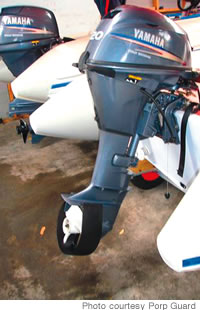Avoiding Injuries With Prop Guards

Putting a prop guard on your propeller could save a life
The death of a 53-year-old North Kohala man who suffered fatal injuries after being struck by a boat’s propeller has renewed discussion about the use of propeller guards in the Islands.
According to Hawaii County police, James C. Williams of Hawi was swimming 300 yards off Mahukona Beach Park when he was hit by a boat’s propeller and knocked unconscious. County officials say he suffered multiple cuts to his head and shoulder and died less than four hours later.
Williams’ death comes four months after a Kaua’i man suffered life-threatening injuries after being struck by a boat’s propeller in the Kaiwi Channel. Luke Evslin nearly bled to death after being sliced on his back last October during the Molokai Hoe canoe race. Evslin is making a miraculous recovery.
“My recovery is going well,” says Evslin. “I’ve started to do sports rehabilitation to get my leg and lower back strength back. Still progressing and things seem to be going well.”
Evslin was lucky. According to national data, 15-17 percent of all prop injuries result in fatalities. A similar rate results in amputations. Emergency doctors say most propeller victims suffer multiple, deep, open wounds. Some doctors even compare the wounds to those seen on a battlefield.
Safety advocates have long preached that propeller guards can greatly reduce the number of injuries and deaths. A propeller guard is a steel cage that surrounds the propeller, which protects the spinning blades from hitting rocks and reef and more importantly people and marine life.
“I definitely feel they could save lives,” says Evslin. “I never actually heard of a prop guard until after my accident so I am far from an expert on them, but after getting hit by a prop I strongly believe that all boat owners should install them.”
Propeller guards have been available for more than five decades. But many boat owners believe they do not prevent injuries and deaths. Some say they affect an engine’s performance and are just a waste of money. Propeller guards range in price from $50 to $350 depending on size and design.
According to Dr. Miguel Mendez-Fernandez, who has written several articles on motorboat propeller injuries, a propeller produces chopping, cutting and penetrating injuries.
“When a propeller makes contact with a body it will result in multiple impacts of great force by the moving and advancing blades of the propeller,” he says. “A 13-inch blade can travel from head to toe in an average person in less than one tenth of a second.”
Evslin is living proof of the damage the blades can cause. Such injuries are usually severe and disfiguring and can result in prolonged disability and permanent impairment. Like others who’ve suffered similar injuries, Evslin also faced a high risk of infection.
“I believe that they minimize injuries,” says Evslin. “People will still get run over, but instead of having a propeller slicing through their body, they will get slammed by the guard. I’m sure that it can still do damage, but it brings the chances of catastrophe down drastically.”
From death to amputation, severe lacerations to substantial blood loss, most prop injuries are preventable. But should boaters be required to install them? Some believe it’s time.
“Even if it takes 1,000 prop guards on 1,000 boats to save a life, it’s worth it,” says Evslin. “I can’t even imagine the argument against them.”
A blog that records news coverage of recent propeller accidents and injuries, including fatalities, can be found at rbbi.com/pgic/propacc/2010.htm.
You must be logged in to post a comment.




There are no comments
Add yours